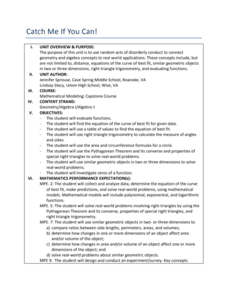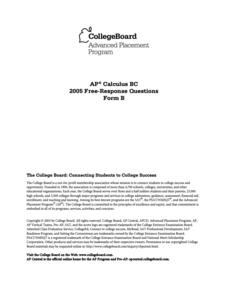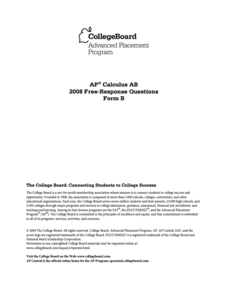Radford University
Catch Me If You Can!
Crime doesn't pay, but everyone can learn from it. Learners consider different situations involving mischief at a school, such as stink bombs and rockets, and analyze them using mathematics. They must apply trigonometry, quadratic...
CK-12 Foundation
Area and Volume of Similar Solids: Similar Solids
Five questions make up an interactive designed to boosts knowledge of area and volume of solid figures. Question types include multiple-choice, true or false, and fill-in-the-blank. A scale model changes measurement to provide a visual...
National Nanotechnology Infrastructure Network
Learning About Surface Area and Volume
Plan a dinner party. Using a book by Marilyn Burns as a context, pupils learn about the relationships between area and perimeter and surface area and volume. The hands-on activities have learners rearrange tables and cut up meatballs to...
New York City Department of Education
Chris’ Garden Dilemma
Make the connections between area, tiling, and multiplication. A performance task and associated unit presents the concept of area and makes the connection to multiplication. Pupils work through three major sections of instruction that...
PHET
Area Builder
All that matters is the tiles. Pupils use the interactive to investigate the relationship between area and perimeter using tiles. The interactive has an explore and a game mode to accommodate different steps in learning. The game mode...
College Board
2011 AP® Calculus BC Free-Response Questions Form B
Take a second look. Form B of the AP® Calculus BC free-response questions allow pupils and teachers to see another set of items. The six questions expand the set of items from the 2011 free-response questions. Form B items include a...
College Board
2010 AP® Calculus BC Free-Response Questions Form B
Keep moving along a curve. Two items in the set of released free-response questions from the 2010 AP® Calculus BC exam involve movement along a graph. One involves particle motion along a polar curve while the other uses a squirrel...
College Board
2009 AP® Calculus BC Free-Response Questions Form B
Let them eat cake. The free-response questions from an AP® Calculus BC exam cover several topics that include finding the area under a curve within the context of creating a birthday cake. Calculus concepts include finding rates of...
College Board
2008 AP® Calculus BC Free-Response Questions Form B
This is integral to the test. Pupils realize that every question in the released free-response items from the 2008 AP® Calculus exam Form B requires integration. By reviewing the additional resources, scholars learn how important it is...
College Board
2007 AP® Calculus BC Free-Response Questions Form B
There is just a single real-world problem. Released free-response items from the 2007 AP® Calculus BC Form B contains only one real-world question. The question involves rate of change of wind chill scenario. The mathematical problems...
College Board
2005 AP® Calculus BC Free-Response Questions Form B
Let's put it in context. Pupils use the AP® Calculus BC free-response questions to practice for the exam. Five of the six released items deal with mathematical problems, with one using a real-world situation. Learners use differentiation...
College Board
2004 AP® Calculus BC Free-Response Questions Form B
Take another look at the exam. A set of questions is a different form for the 2004 AP® Calculus BC free-response question section. The questions are evenly split into calculator and non-calculator sections. Pupils use their knowledge of...
College Board
2003 AP® Calculus BC Free-Response Questions Form B
Be integral to the learners in the classroom. Pupils use integrals, differentiation, and limits to solve the free-response questions from an AP® Calculus BC exam. Items cover topics such as area under a curve, particle motion, average...
College Board
2002 AP® Calculus BC Free-Response Questions Form B
Though the items may be older, they still provide information. Released free-response items from the 2002 AP® Calculus BC exam provide teachers and pupils with information about how topics appear on the exam. Questions come from the AB...
College Board
2011 AP® Calculus BC Free-Response Questions
Does the exam look pupils expected? Released free-response questions from the AP® Calculus BC exam allow teachers and pupils to see and practice with actual exam questions. Three of the questions come from the AB portion of the course...
College Board
2011 AP® Calculus AB Free-Response Questions Form B
Half are real-world. The 2011 AP® Calculus AB free-response questions let pupils and teachers see how content appears on the exam. Half of the questions contain real-world context, and four items do not allow calculators. Real-world...
College Board
2010 AP® Calculus AB Free-Response Questions Form B
Most say that practice makes perfect. Scholars use the released free-response questions to practice for the AP® Calculus AB exam. Each question comes with several parts and either do or do not allow calculators. Items include topics such...
College Board
2008 AP® Calculus AB Free-Response Questions Form B
How would those items score? The resource provides pupils an opportunity to answer actual free-response questions and determine their scores. Items from the AP® Calculus AB exam from the 2008 administration demonstrate how topics appear...
College Board
2007 AP® Calculus AB Free-Response Questions Form B
What do the questions look like? Six free-response questions provide pupils with knowledge of how calculus topics appear on the AP® Calculus exam. The questions involve calculator and non-calculator problems by providing mathematical and...
College Board
2005 AP® Calculus AB Free-Response Questions Form B
Grab a peak inside the test. The 2005 free-response questions from the AP® Calculus exam allow learners to see how topics appear on the tests. Topics cover differential equations, bounded areas, particle motion, and slopes of tangent lines.
College Board
2004 AP® Calculus AB Free-Response Questions Form B
The test is not all about skills. The six free-response questions contain two real-world application problems. Those items deal with populations and velocities. The other four questions ask pupils to show their knowledge of calculus...
College Board
2002 AP® Calculus AB Free-Response Questions Form B
Become better at the test concepts. An educational resource presents six free-response questions from the AP® Calculus AB exam. Pupils use the items to practice the content, which contains concepts ranging from particle motion to ships...
College Board
2009 AP® Calculus AB Free-Response Questions Form B
Get a free peek into a calculus exam. Released free-response items from the AP® Calculus AB exam provide teachers and pupils examples of how topics may appear. The six questions cover topics such as growth rates, volumes of rotations,...
College Board
2006 AP® Calculus AB Free-Response Questions Form B
An exam divides the six free-response questions into calculator use and no calculator use items. The non-calculator items are conceptual in nature and test whether pupils understand the calculus concepts. Scholars explain their answers...

























